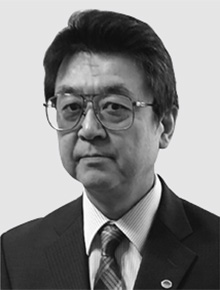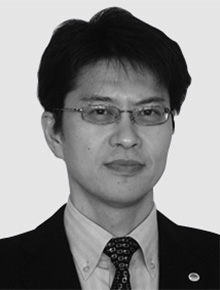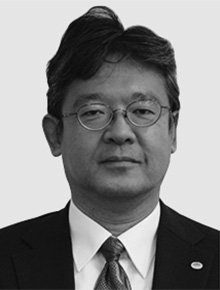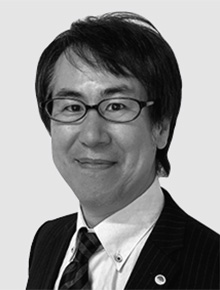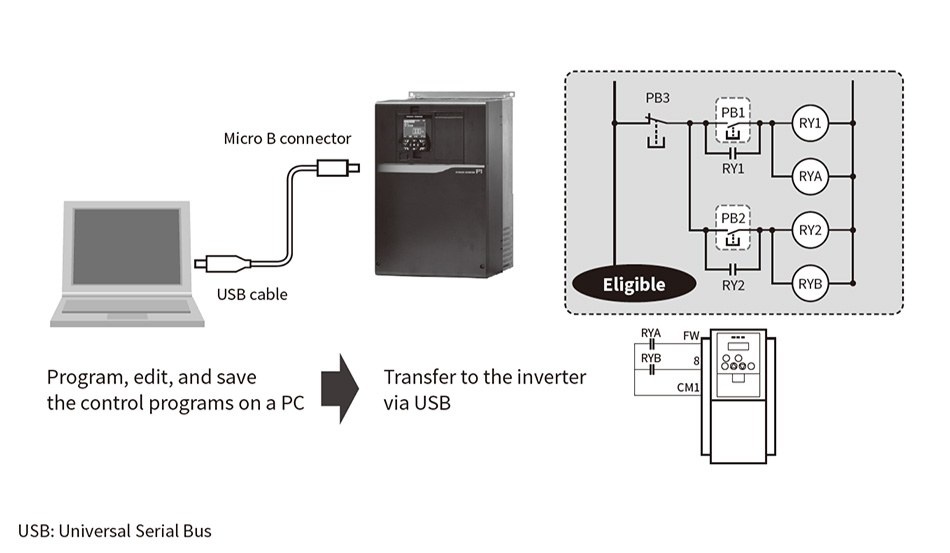Services, Systems, and Products for Smarter FactoriesProducts for Power Drive Systems for Enhancing Energy Efficiency and Adding Value for Equipment
Highlight
Drive products such as motors, inverters, and servos are responsible for the power control of factory equipment and the driving control of manufacturing machines. Up to now, Hitachi has commercialized top runner motors as well as amorphous motors, which have the highest level of international efficiency standards and contribute to the energy savings and space reduction of applied equipment. The scope of application of Hitachi’s inverters has been expanded by the advancement of motor control, and they are contributing to the improvement of the added value of the equipment by capturing peripheral control or with customized specifications. Hitachi’s Servo with low inertia and high torque have demonstrated their benefits in large production machines, where electrical drive is increasingly being used in place of hydraulics, including in the molding of large and thin panels. They also facilitate adoption of the Internet of Things, enabling the collection of rapidly varying drive data. This article describes these drive products using examples of collaborative creation with customers.

1. Introduction
While the adoption of the Internet of Things (IoT) and advances in software such as applications for artificial intelligence (AI) have tended to catch people’s attention amid the shift to smarter factories, these digital solutions cannot be made without progress in the hardware of control and communications equipment, especially the performance improvement of the semiconductor devices that are among their key components. These technologies have been enabled by advances in manufacturing processes such as machining and forming, creating demand for greater speed and precision, and faster data processing in the drive systems used to drive and control the mechanisms of production machinery.
Meanwhile, environmental protection considerations are bringing increasingly severe requirements for equipment energy efficiency, including in some cases the introduction of rules on the efficiency of the electric motors used in this equipment. There is also a need to respond to those requirements for the safety of machinery and impact on the surrounding environment, with Europe and USA leading the way on introducing standards and regulations. These standards and regulations include European Union (EU) directives such as the Low Voltage Directive, Electromagnetic Compatibility Directive, and Machinery Directive designating drive systems as being within their scope, and also the acquisition of certifications for Underwriters Laboratories (UL) LLC standards and various functional safety standards.
Improvements in energy efficiency, cleanliness, and flexibility are being made through the replacement of hydraulics with electrical drive. The control performance of large production equipment such as injection molding machines is being enhanced by the use of high-speed fieldbus, and the use of fully electrical drive is becoming more common. This is improving repeatability through the use of position and speed data during drive operation and building momentum behind the adoption of the IoT through the collection and storage of large amounts of data.
As drive systems have a significant influence on the performance and features of the equipment in which they are used, adding more value through collaborative creation with customers to further enhance these products is an important task.
2. Taking up the Challenge of Global Warming through Motors and Application Technologies
2.1 Improving Efficiency of Three-phase Induction Motors
The need to reduce energy consumption is part of the challenge of preventing global warming. It is estimated that three-phase induction motors account for 40 to 50% of total global power consumption, approximately 55% of power consumption in Japan, and approximately 75% of power consumption by industry. This has led the International Electrotechnical Commission (IEC) to define five international energy efficiency classes (IEs) for three-phase induction motors (IE1 to IE5)*1 to encourage action at a national level. Revisions to Japan’s Act on the Rational Use of Energy have designated three-phase induction motors as coming under the scope of the Top Runner standards, requiring that all such motors satisfy this criterion (equivalent to IE3) from FY2015(1).
It is against this background that Hitachi Industrial Equipment Systems Co., Ltd. (Hitachi IES) launched a range of Top Runner motors in the 0.75- to 300-kW range that, thanks to the use of electromagnetic field analysis for optimal design and improvements to the cooling design, can be swapped in for existing motors without modifications. The motors are designed for ease of use, with other features including a higher heat resistance class, an IP55 rating for protection against dust and water (on models intended for outdoor use), the ability to work with a wide range of power supply voltage, and lower noise (see Figure 1).
- *1
- The highest class, IE5, is currently defined by interim values.
Fig. 1—Hitachi IES’s Series of Top Runner Motors Use of electromagnetic field analysis for optimal design together with other enhancements that include improvements to the cooling design have enabled these motors to be direct replacements for existing motors. The motors are designed for ease of use, with features that include a higher heat resistance class, IP55 dust and water protection (on models intended for outdoor use), the ability to work with a wide range of power supplies, and lower noise.
Use of electromagnetic field analysis for optimal design together with other enhancements that include improvements to the cooling design have enabled these motors to be direct replacements for existing motors. The motors are designed for ease of use, with features that include a higher heat resistance class, IP55 dust and water protection (on models intended for outdoor use), the ability to work with a wide range of power supplies, and lower noise.
2.2 Further Efficiency Improvements
Fig. 2—Simplified Diagram of Amorphous Motor (Top) and Example of Customized Motor Installation (7.5 kW, 3,600 min-1)(Bottom). The challenges of using amorphous alloy in a motor were overcome by a simple core geometry and the powerful magnetic flux provided by a double rotor. The motor is easy to fit inside machinery because it has a disk shape, meaning the design has little effect on the axial length.
The challenges of using amorphous alloy in a motor were overcome by a simple core geometry and the powerful magnetic flux provided by a double rotor. The motor is easy to fit inside machinery because it has a disk shape, meaning the design has little effect on the axial length.
The main uses for three-phase induction motors include pumps, compressors, and fans and there are an increasing number of examples in which power consumption was reduced by operating the inverter at variable speeds according to the required workload. The use of permanent magnet (PM) motors is another way to improve efficiency. Hitachi IES has been supplying custom PM motors for machinery such as pumps and compressors and has added a series of standard models in the 3.7- to 55-kW range that use the same design and production technologies to deliver IE4-class energy efficient products that have been commercially available since 2012.
Work has also proceeded on achieving IE5-class energy efficiency. The outcome of this work was an amorphous motor that achieves low losses by having a laminated core made of amorphous iron alloy foil. The motor design allows for the fact that amorphous metal is difficult to work with by choosing an axial gap configuration that uses a simple core geometry, also taking account of resource concerns to use a ferrite magnet by utilizing the powerful magnetic flux provided by a double rotor. Along with its very high efficiency, the amorphous motor also has benefits to offer when used as a component in other equipment, with the 7.5 kW/3,600 min−1 model being only about 65% as long as an induction motor, making it easy to fit inside machinery (see Figure 2).
2.3 Synergies through Use in Other Equipment
The small size of PM motors makes them suitable for installation inside other equipment. In air compressors fitted with a built-in PM motor and a dedicated controller module, the direct coupling of the motor to the air-end increases the efficiency of power transmission and boosts the mechanical efficiency of the compressor (see Figure 3).
An oil-free scroll compressor equipped with the amorphous motor described above has been made more compact than the previous model, being only 37% as large by volume in the case of the 7.5-kW model. This serves as an example of how a motor can add value to a compressor. The oil-free scroll compressor with a built-in amorphous motor is commercially available now (see Figure 4).
Fig. 3—PM Motor Fitted inside Air Compressor The small size of PM motors facilitates installation inside other equipment. The direct coupling of the motor to the air-end increases the efficiency of power transmission and boosts the mechanical efficiency of the compressor.
The small size of PM motors facilitates installation inside other equipment. The direct coupling of the motor to the air-end increases the efficiency of power transmission and boosts the mechanical efficiency of the compressor.
Fig. 4—Oil-free Scroll Compressor with Built-in Amorphous Motor The compressor was reduced to 37% of its previous size (for the 7.5-kW model) by locating the disc-shaped motor inside it.
The compressor was reduced to 37% of its previous size (for the 7.5-kW model) by locating the disc-shaped motor inside it.
3. Control Products that Add Value to Machinery
3.1 Inverter Performance Improvement
Fig. 5—Inverter Product Range of Hitachi Industrial Equipment Systems The main models in the range are designed for drive performance and can drive both IM and PM motors. For ease of use, the EzSQ function is available for programmed operation. For flexibility, the inverters support a variety of industrial networks and certification under international standards such as CE, UL, and c-UL.
The main models in the range are designed for drive performance and can drive both IM and PM motors. For ease of use, the EzSQ function is available for programmed operation. For flexibility, the inverters support a variety of industrial networks and certification under international standards such as CE, UL, and c-UL.
Fig. 6—Block Diagrams of IM Sensorless Vector Control (Left) and Smart Vector Control Developed for PM Motors (Right)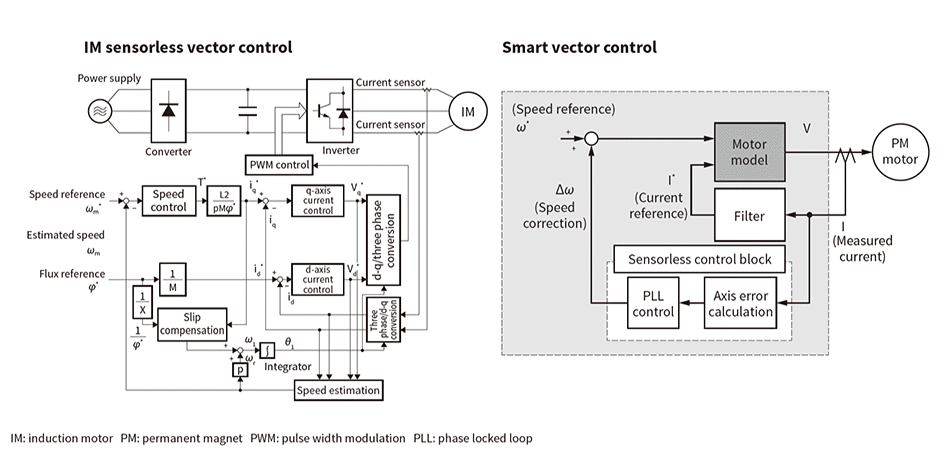 Smart vector control uses PLL control to keep axis error to zero, thereby achieving the accuracy of pole position detection needed for PM motor control.
Smart vector control uses PLL control to keep axis error to zero, thereby achieving the accuracy of pole position detection needed for PM motor control.
More than 30 years after they first entered widespread use, competition still continues on the development of inverters with higher energy efficiency, superior drive characteristics, and additional functions. Drive control in particular serves as a barometer of product performance, with more advanced techniques being demanded to keep pace with improvements in motor efficiency.
The current mainstays of Hitachi IES’s product range are the SJ-P1 series of standard inverters and the WJ200 series of compact inverters. The range is designed to suit a wide variety of needs, featuring a high level of flexibility in terms of the district in which they can be launched or applicability to various industrial networks as well as drive performance and ease of use (see Figure 5).
In terms of drive performance, the inverters are equipped with sensorless vector control for both induction motors (IMs) and PMs (called smart vector control in the latter case), with the same inverter being able to drive both types of motors (see Figure 6). As the slip compensation calculation used in the control of IMs requires accurate values for motor constants, Hitachi IES has put a lot of effort into enhancing the auto-tuning function. On the other hand, in the case of PM motor control, pole positioning during starting and speed detection accuracy at low speeds are crucial. Along with the harmonic injection method used in the past, the company has also improved torque characteristics in the zero-speed range by developing the new “induced voltage caused by magnetic saturation” (IVMS) technique(2) that can also be used on motors that do not have saliency (see Figure 7). Hitachi IES has also made improvements to sensorless control at low speed to allow motors to be started with only a short time for direct current (DC) positioning (see Figure 8).
The easy sequence (EzSQ) function, meanwhile, has been added to make motors easier to use (see Figure 9). This incorporates the functions of inverter peripheral circuits to enable the inverter to perform a full sequence of operations on its own, allowing users to write their own programs for operating sequences and branching based on inputs as well as for protection or switching of operations based on internal inverter information. These user programs can also be refined through collaborative creation with customers into more suitable programs for embedding into equipment.
Fig. 7—New Drive Technique for PM Motors Available in SJ-P1 Series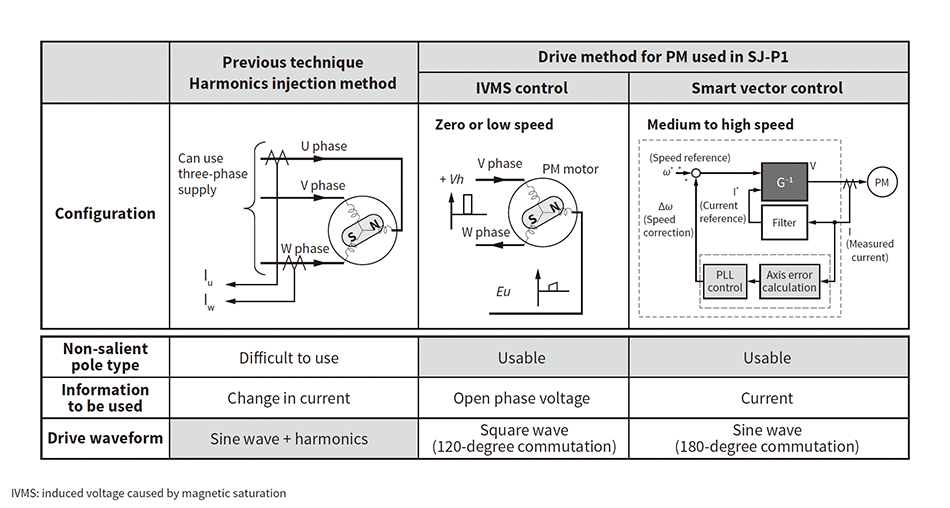 Hitachi developed the new IVMS technique for determining the position of the motor poles from the voltage induced by magnetic saturation, a consequence of small changes in inductance due to the magnetic circuit characteristics. This provides highly accurate estimation regardless of the motor configuration and saliency and is used to control the motor from startup and through the low speed range.
Hitachi developed the new IVMS technique for determining the position of the motor poles from the voltage induced by magnetic saturation, a consequence of small changes in inductance due to the magnetic circuit characteristics. This provides highly accurate estimation regardless of the motor configuration and saliency and is used to control the motor from startup and through the low speed range.
Fig. 8—Old and Newly Improved Methods for Startup, Comparison of Motor Accelerations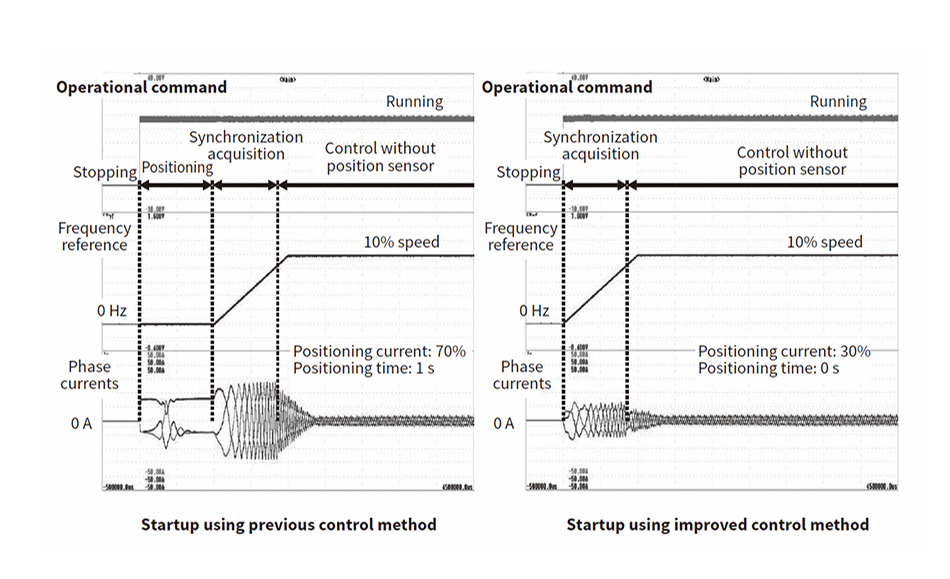 Improved sensorless control at low speed shortens the positioning time and reduces the current. This has expanded the scope of potential applications. The positioning time is not always reduced to zero, depending on factors such as the load.
Improved sensorless control at low speed shortens the positioning time and reduces the current. This has expanded the scope of potential applications. The positioning time is not always reduced to zero, depending on factors such as the load.
3.2 Customization and Incorporation into Machinery through Collaborative Creation with Customers
Fig. 10—Hoist Control Panel and Hoist Inverter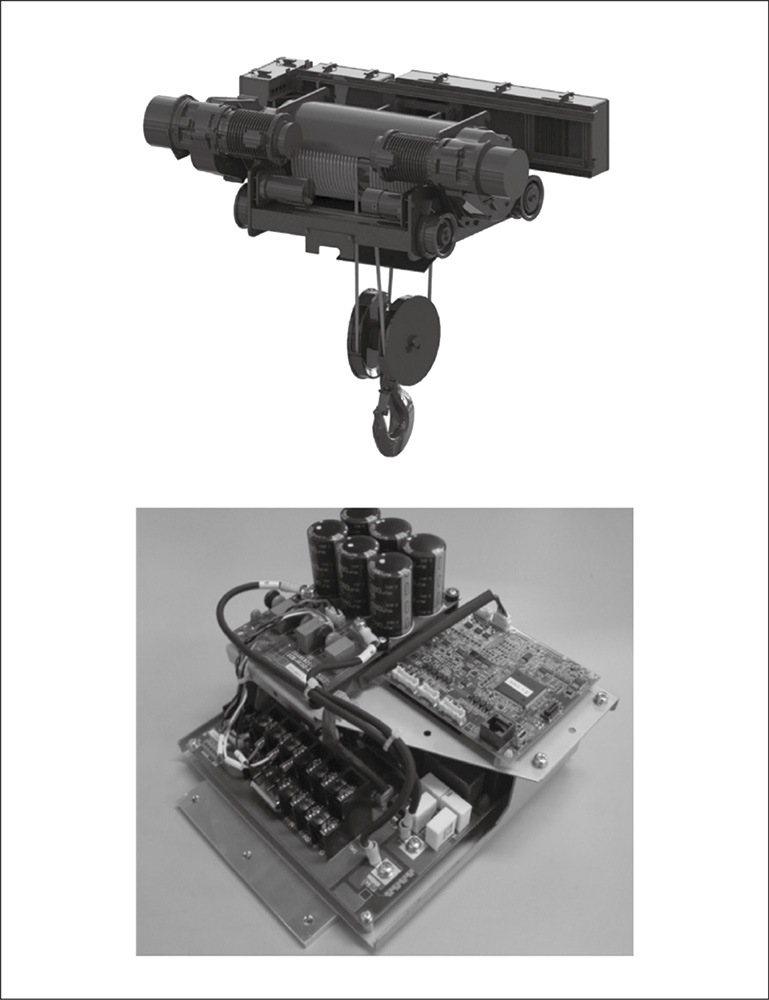 Embedded to the moving part (top), the hoist control panel is fully enclosed to allow for outdoor installation and incorporate the electrical regeneration circuit. The regeneration converter and inverter are integrated into a single package with fan-less cooling (bottom) that is easier to fit into the hoist and helps to make it smaller.
Embedded to the moving part (top), the hoist control panel is fully enclosed to allow for outdoor installation and incorporate the electrical regeneration circuit. The regeneration converter and inverter are integrated into a single package with fan-less cooling (bottom) that is easier to fit into the hoist and helps to make it smaller.
The customization of drives to suit customer machinery includes the possibility of allocating critical functions. The following section gives an example of the collaborative creation of Hitachi IES products.
While past practice for hoist applications was to use a set including an SJ700 series standard inverter and an RC700 series regenerating converter with 120-degree commutation, the two units have been combined into a single SJ-P1-based control board using a design that integrates the inverter and converter. The new configuration also features natural cooling inside an electrical system that is fully enclosed for outdoor installation and acts as a cold plate through the use of the cooling system in the hoist to also cool the power circuits. This has helped to make the hoist more competitive in the market by making the hoist electrics smaller and lighter (see Figure 10).
The oil-free scroll compressor equipped with the amorphous motor described above uses PM sensorless vector control. Whereas auto-tuning is normally required to obtain the motor characteristics, customization means that the PM motor characteristics can be determined in advance, allowing for pairing. The system is also capable of detecting step-out (loss of synchronization) based on the difference between motor currents during normal operation and during step-out. As this is implemented using EzSQ, adjustments can be made easily.
In this way, along with providing inverters with more advanced drive control techniques to go with more efficient motors, Hitachi is also adding value by customizing them to work with customer machinery.
4. Servos that Facilitate Adoption of Electrical Drive in Large Machines
Along with increasing demand for improvements in energy efficiency, noise, and cleanliness as well as use of the IoT over recent years, there has also been an accelerating shift away from hydraulic systems and toward the use of electrical drive as servo motors have become larger and are achieving faster response performance. This section describes servos intended for electrical drive applications in large machines.
4.1 Servo Systems with Low Inertia and High Torque
Fig. 11—Servo System with Low Inertia and High Torque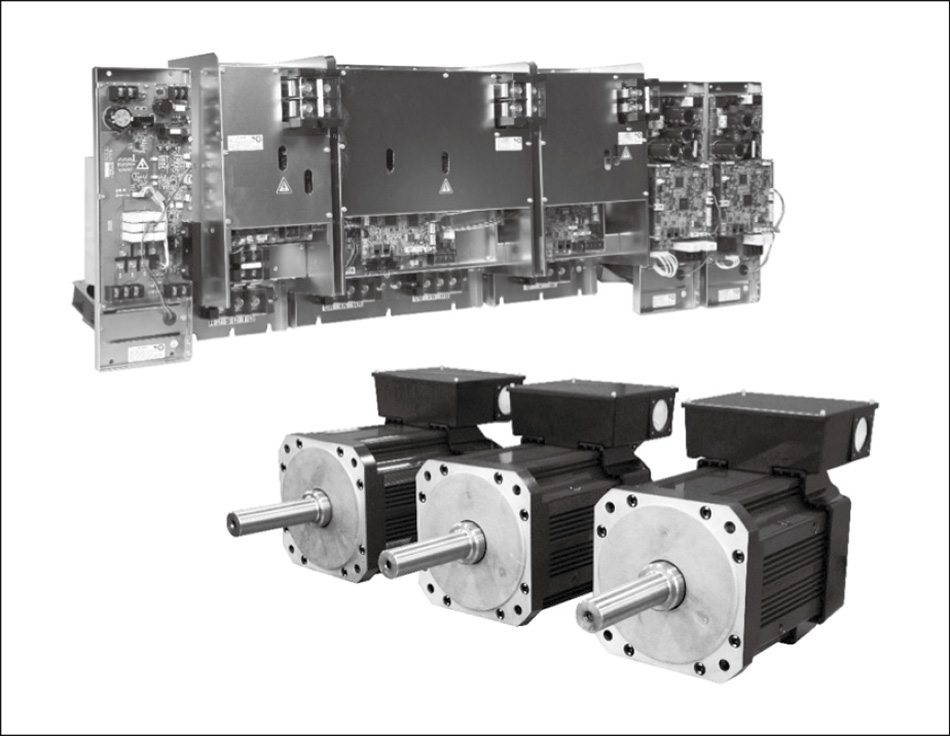 The photographs show the ADV-MEGA servo amplifier and ADMR servo motor. Hitachi IES uses its own proprietary motor control for utilizing reluctance torque, with high-speed processing to enable precise machining with high levels of repeatability even when operation involves rapid sequences of acceleration, deceleration, and halting.
The photographs show the ADV-MEGA servo amplifier and ADMR servo motor. Hitachi IES uses its own proprietary motor control for utilizing reluctance torque, with high-speed processing to enable precise machining with high levels of repeatability even when operation involves rapid sequences of acceleration, deceleration, and halting.
Fig. 12—Injection Molding Machine Made by Toyo Machinery & Metal Co., Ltd.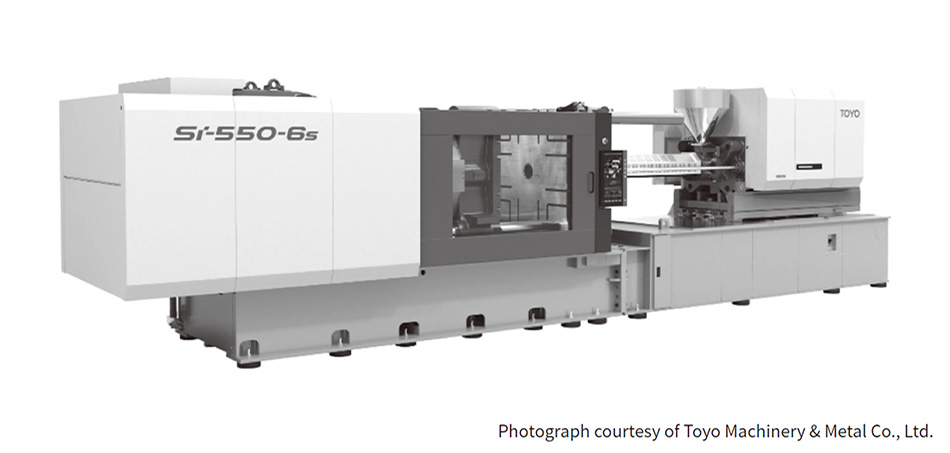 Toyo Machinery & Metal injection molding machines equipped with the ADV-MEGA servo amplifiers and ADMR servo motors are designed to provide industry-leading high speed and precision through the use of servo technologies suited to how their respective machine parts operate. They also support the EtherCAT high-speed motion network.
Toyo Machinery & Metal injection molding machines equipped with the ADV-MEGA servo amplifiers and ADMR servo motors are designed to provide industry-leading high speed and precision through the use of servo technologies suited to how their respective machine parts operate. They also support the EtherCAT high-speed motion network.
Hitachi IES supplies servo systems with low inertia to shorten cycle times for customer machinery, and has also launched models with higher torque in response to the upsizing of these machines. The motors use a rotor with embedded magnets, enabling the use of reluctance torque, and also feature a core geometry obtained by magnetic field analysis that both provides the required flux and minimizes rises in magnet temperature.
In addition, the motor control program built into the servo amplifier has an original high-speed processing method for effective use of reluctance torque, and this minimizes control delays in machine operations that involve rapid sequences of acceleration, deceleration, and halting. This in turn enables the machines to perform precise machining with a high level of repeatability (see Figure 11).
4.2 High-speed Communications over EtherCAT
Demand for fast and precise machining together with the adoption of the IoT make it important that control systems as a whole operate more quickly, with short cycle times for communication between servo amplifiers and higher-level systems, accompanied by the monitoring of drive statuses and sensors. To satisfy these requirements, Hitachi IES has commercialized a servo system for Toyo Machinery & Metal Co., Ltd. with injection molding machines that use EtherCAT*2 communications. This uses a custom packet format intended specifically for four-axis injection molding machines and enables the machines to operate rapidly with fast acceleration and deceleration while also providing the improvements in repeatability needed for molding quality(3) (see Figure 12).
- *2
- EtherCAT is a registered trademark and patented technology licensed from Beckhoff Automation GmbH of Germany.
4.3 Variable Control of Converter DC Voltage
Power supply systems for large machines require the capacity to supply the heavy currents needed for high torque. Large capacitors are also necessary to absorb the sudden surges in output energy and regeneration energy that occur with severe acceleration and deceleration. To satisfy these requirements effectively, converter voltage step-up control has been coupled with control of motor acceleration and deceleration. This involves reducing the step-up voltage just before the deceleration where regenerative energy would increase the step-up voltage, thereby preventing overcharging and utilizing regenerative energy(4) (see Figure 13). This enables a reduction of approximately 30% in the electrolytic capacitor requirements and also reduces peak current by about 30%*3 (see Figure 14).
- *3
- One example obtained in comparison with a previous method (based on research by Hitachi IES)
4.4 Coupled System Simulator
Improving machine performance through an accurate assessment of the behavior of each component requires not only a study of the control, electrical, and mechanical systems in isolation, but also consideration of the drive system as a whole. To do just this, Hitachi’s Research & Development Group and Hitachi IES have developed a coupled system simulator(5) that can simulate the motor, electrical circuits, and mechanical components coupled with each other. By detailed analysis of operational data of each component using the simulator, improvements based on the evaluation results are implemented for commercial drive systems, and these are used to investigate ways of identifying and minimizing unwanted behaviors across the entire drive system (see Figure 15).
Fig. 13—Variable DC Voltage Control in Converter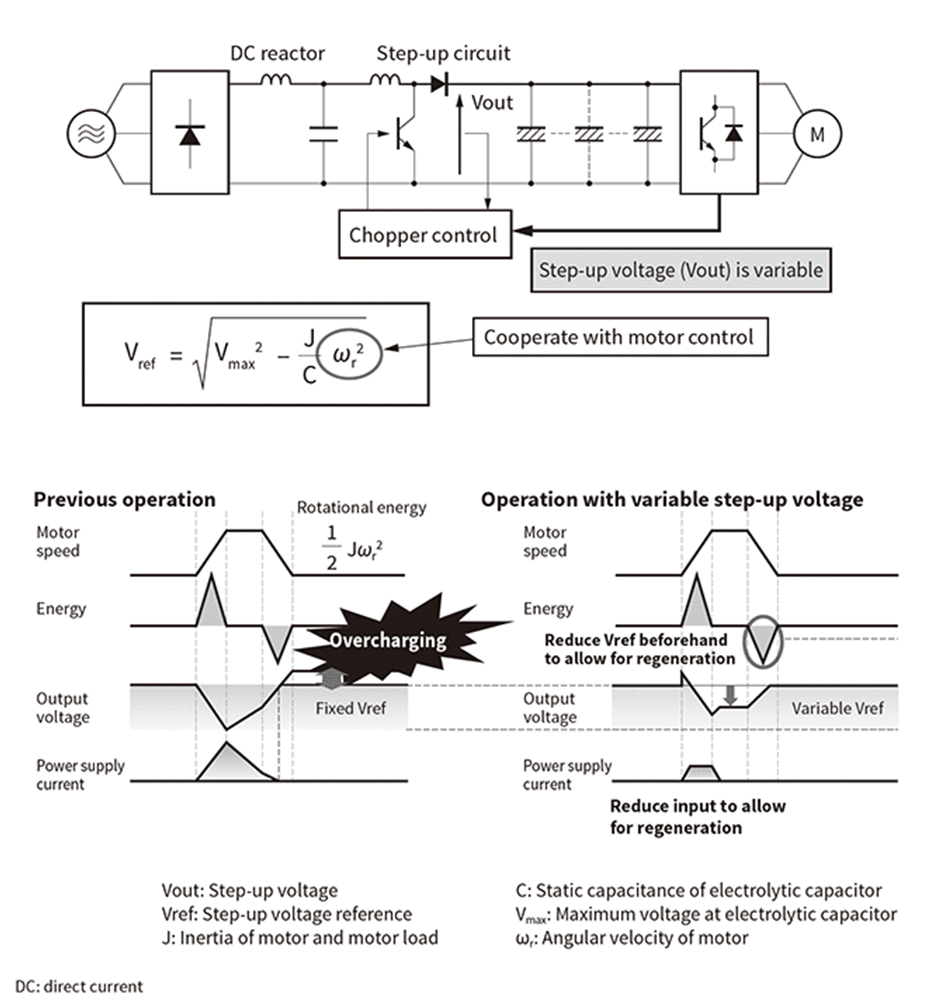 Variable control of DC voltage is made possible by the addition of a step-up circuit. Overcharging during regeneration is prevented by reducing the step-up voltage reference based on motor speed.
Variable control of DC voltage is made possible by the addition of a step-up circuit. Overcharging during regeneration is prevented by reducing the step-up voltage reference based on motor speed.
Fig. 14—Benefits of Variable DC Voltage Control in Converter (Example)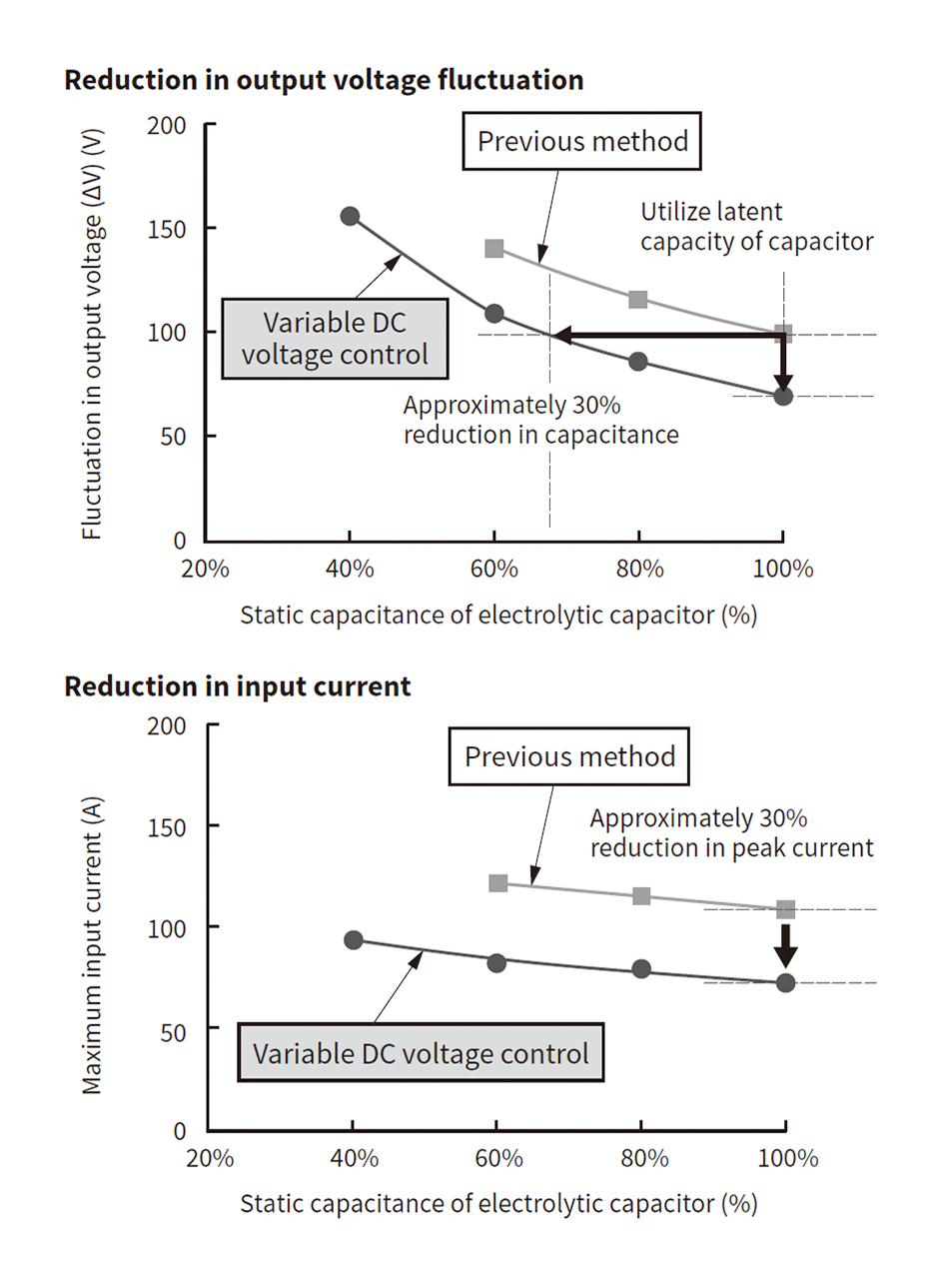 The elimination of overcharging reduces voltage fluctuation and this in turn allows for a smaller electrolytic capacitance. The input current from the power supply is also smoother.
The elimination of overcharging reduces voltage fluctuation and this in turn allows for a smaller electrolytic capacitance. The input current from the power supply is also smoother.
Fig. 15—Block Diagram of Coupled System Simulator and Control Enhancements Using Model of Mechanical System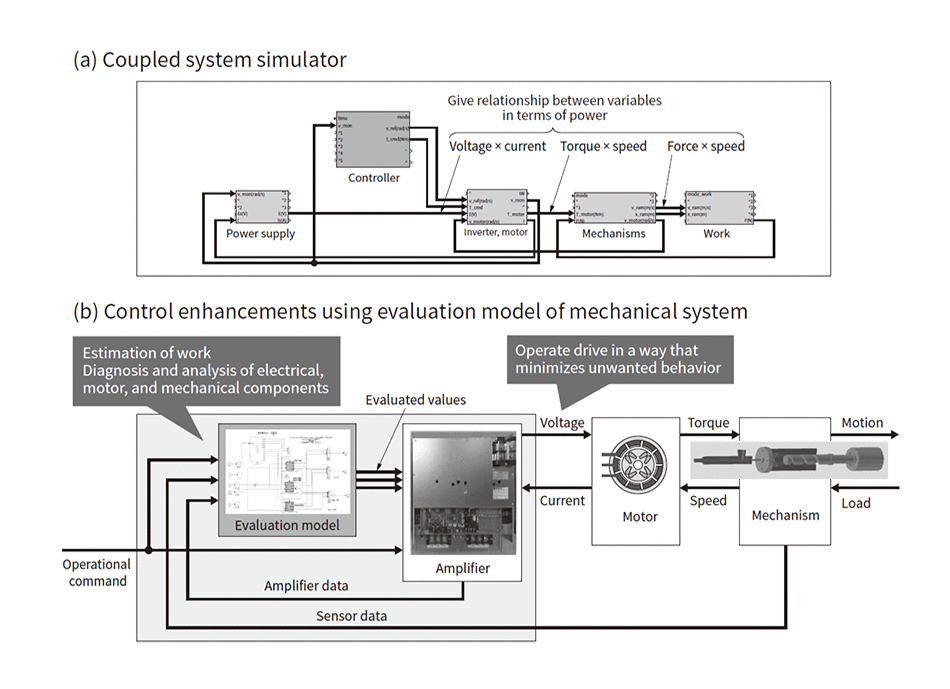 The operation of the system as a whole, including the mechanical parts of the machine, can be studied by using a coupled calculation in which the separate calculations for the control, electrical, and mechanical parts of the system are linked together by power and coupling parameters. This analytical model is used to make improvements to motor drive systems, including changes in drive torque and switching between operating modes.
The operation of the system as a whole, including the mechanical parts of the machine, can be studied by using a coupled calculation in which the separate calculations for the control, electrical, and mechanical parts of the system are linked together by power and coupling parameters. This analytical model is used to make improvements to motor drive systems, including changes in drive torque and switching between operating modes.
5. Conclusions
This article has described the drive-related products of Hitachi Industrial Equipment Systems. These products will continue to become smaller and more energy efficient, contributing to equipment by providing benefits such as startup performance, ease-of-use, high torque, and high-speed control.
For the life cycle management of machinery, meanwhile, Hitachi’s Research & Development Group is developing techniques for detecting the presence of equipment problems based on distinctive changes in motor currents and suggesting the best time for conducting maintenance inspections(6), (7). In the future, it is anticipated that new forms of collaborative creation will become possible by equipping drive systems with the ability to detect such distinctive fluctuations in their own internal data and notify these results together with linked information on the condition of customer machines. Hitachi intends to continue working on ways of furthering the adoption of the IoT from the perspective of drives.
REFERENCES
- 1)
- The Japan Electrical Manufacturers’ Association, “For Global Environmental Protection and Energy Saving—Top Runner Motors,” in Japanese. (PDF Format, 6.35MB)
- 2)
- Y. Iwaji et al., “Position Sensorless Drive in Low-Speed Region for Permanent Magnet Synchronous Motors Using Induced Voltage Caused by Magnetic Saturation,” The Institute of Electrical Engineers of Japan, Transactions on Industry Applications, 134, 8, pp. 703–711 (2014) in Japanese.
- 3)
- design JAPAN news, “TOYO Develops Injection Molding Machine with 10G Acceleration,” (Oct. 2009) in Japanese.
- 4)
- T. Ishigaki et al., “Proposed Inverter DC Bus Voltage Control Method and Capacitance Reduction Method for Mass Motor Drive,” The Institute of Electrical Engineers of Japan, Transactions on Industry Applications, 134, 3 pp. 344–349 (Mar. 2014) in Japanese.
- 5)
- M. Yamasaki et al., “Development of a Coupled System Simulator for an Air Screw Compressor,” Transactions of The Japan Fluid Power System Society, 41, 3, pp. 52–58 (May 2010) in Japanese.
- 6)
- Hitachi News Release, “Development of Consumables Deterioration Detection Technology Using Machine Tool Built-in Motor as Sensor,” (Jun. 2018), in Japanese.
- 7)
- Hitachi News Release, “Hitachi Launches Predictive Diagnosis Solution that Automatically Detects Abnormalities in Motor-related Equipment using AI, Based on Current Data,” (Jul. 2019), in Japanese.

